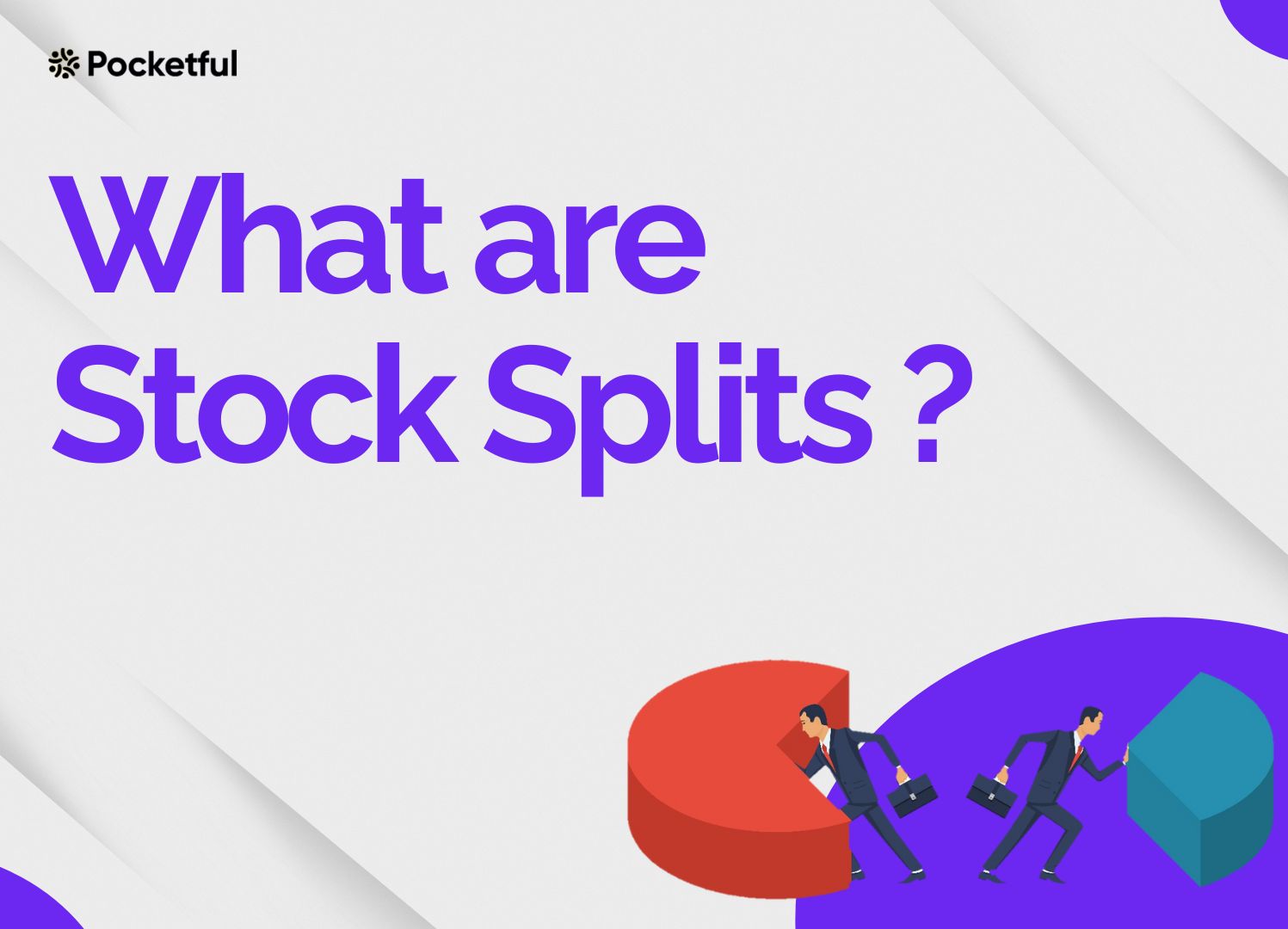| Type | Description | Contributor | Date |
|---|---|---|---|
| Post created | Pocketful Team | Jun-03-24 | |
| Add new links | Nisha | Mar-12-25 |

- Blog
- stock splits
What are Stock Splits? Meaning, Reason, Types, and Impact Explained

Stock split is a unique corporate action in which the shareholder’s shares get divided into multiple shares. While the overall value of the shares remains the same, the shares increase in number.
But what exactly is a stock split, and why does it matter to investors in India? This blog will answer all your questions regarding stock split.
Stock Splits Meaning

A stock split is when a company divides its existing shares into multiple shares. However, the total market value of the company doesn’t change, even though the number of shares increases.
You can imagine cutting a piece of pie into smaller portions — while the number of pieces increases, the total amount of pie remains the same. This move is generally done to make individual shares more affordable and attract a wider range of investors who were unable to enter due to the high price point.
Reason for Stock Splits
Companies make use of stock splits to make their shares more appealing and accessible to investors. When a company’s share price shoots up drastically, it can discourage small scale investors from buying. Therefore, by splitting the stock, companies lower the price per share, making it more affordable and thus increasing liquidity.
For example, imagine a company’s share price has increased to ₹10,000. Many retail investors might find it too expensive to invest. However, if the company announces a 10-for-1 stock split, each share’s price would drop to ₹1,000, making it more attainable for a larger audience.
Types of Stock Splits

There are broadly two types of stock splits. They are explained below:
- Forward Stock Split – This is the most common type of split, where the number of shares increases and the price per share decreases. For instance, in a 2-for-1 split, each existing share splits into two, doubling the number of shares and cutting the price per share in half.
- Reverse Stock Split – This type is relatively less common, it involves reducing the number of shares, which in turn increases the price per share. For example, in a 1-for-5 reverse split, five shares are consolidated into one, making the price of each share five times higher.
Psychological Impact of Stock Split
Stock splits can have a significant psychological impact on investors. When a company announces a stock split, it creates a perception of growth and confidence in the company’s future. This perception is largely based on the idea that the company seeks the trust of retail investors.
This positive sentiment can drive up demand for the stock, sometimes leading to an increase in the stock price post-split, even though the overall market value of the company remains unchanged.
Calculations of a Stock Split

Let’s break down the calculation with an example. Suppose you own 100 shares of a company, XYZ Limited, with each share priced at ₹500. Your total investment is ₹50,000 (100 shares x ₹500).
XYZ Limited then announces a 2-for-1 stock split. After the split, you will own 200 shares, but the price per share will be halved to ₹250. Thus, your total investment remains the same at ₹50,000 (200 shares x ₹250).
Similarly, if XYZ Limited opted for a 3-for-1 stock split, you would end up with 300 shares priced at approximately ₹166.67 each, maintaining the total value of your investment.
The market value of the company remains the same after the stock split, thus reducing the value of each share.
Pros and Cons of Stock Splits
Pros
- Increased Liquidity – More shares at a lower price can increase trading volume and liquidity.
- Enhanced Affordability – Lower-priced shares are more accessible to small investors, widening the shareholder base.
- Positive Market Perception – A stock split can signal that the company is performing well and expects future growth.
Cons
- No Fundamental Change – A stock split doesn’t change the company’s fundamentals. It’s more of a cosmetic change without affecting the company’s market capitalization or intrinsic value.
- Possible Volatility – Post-split, stocks can experience higher volatility as new investors start investing. This increase in demand can make the stock appear more valuable than it actually is.
Read Also: What is a Bonus Issue? Meaning, Process, Key Dates, and Impact Explained
How can I track Stock Splits?
Generally, listed companies publish all the corporate announcements at stock exchanges first, i.e., NSE and BSE in India. However, it will be cumbersome for you to monitor updates from each company individually.
To simplify this process, we’ve created a dedicated corporate action page where you can effortlessly track all the latest corporate announcements, including but not limited to dividends, rights, splits, and bonus issues.
You can access the corporate actions page to get the detailed list.
But that’s not all. In addition to our corporate actions page, we recently launched our new WhatsApp service. Now, you can effortlessly stay informed about all corporate actions, including dividends, bonuses, splits, and more, delivered straight to your phone every morning by 9 A.M. for just INR 11!
Sign up now and never miss any corporate announcement.
Conclusion
Stock splits play a crucial role in making shares more accessible and enhancing market liquidity. Although they don’t alter a company’s fundamental value, they can significantly influence investor perception and market dynamics.
Understanding stock splits is extremely important for investors, as it equips them with the knowledge to navigate the market more effectively.
Frequently Asked Questions (FAQs)
Is it mandatory for the listed companies to declare a stock split or reverse stock split once the share price reaches a certain point?
No, it is entirely optional for companies. For example, MRF Ltd. has never done a stock split, and its shares are currently among the most expensive shares to purchase in the Indian share market.
What is the key difference between Forward Stock Split and Reverse Stock Split?
The key difference between the two is that a forward stock split increases the number of outstanding shares, and a reverse stock split decreases the number of outstanding shares. The total market value of the organization remains the same in both cases.
Is there any impact on liquidity by stock split?
Yes, the liquidity of the stock is increased after a stock split as it increases the number of outstanding shares of the company and decreases the price per share, making it affordable to potential investors.
Who announces the stock split?
The company’s Board of Directors have the authority to announce a stock split.
Is there any impact of a stock split on the company’s fundamentals?
No, there is no impact of a stock split on the company’s fundamentals.
Disclaimer
The securities, funds, and strategies discussed in this blog are provided for informational purposes only. They do not represent endorsements or recommendations. Investors should conduct their own research and seek professional advice before making any investment decisions.